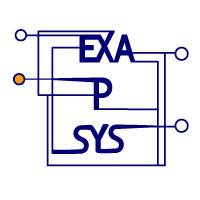
Network: the next big bottleneck?

Network interconnect is the backbone of a supercomputer, connecting together the compute nodes

To reach the exascale with a reasonable power consumption, exascale supercomputers will include a huge number of nodes, and they will be hybrid nodes integrating GPUs and CPUs

Integrating heterogeneous nodes requires a smarter interconnect, with additional features to accelerate connectivity between servers and storage
Those are the challenges that RED-SEA is tackling to design the network interconnect that will power future European Exascale systems

The RED-SEA blog
By the RED-SEA experts
Latest blog
- Optimizations for collective communications primitives (CCP)
 Authors: José Duro, Adrián Castelló, Maria Engracia Gomez, Julio Sahuquillo, Enrique Quintana (UPV) 1 Introduction In this blog entry, we present the characterization of the network congestion for the target RED-SEA applications. This congestion is mainly due to collective communication operations, and therefore some of the optimizations for collective communications primitives (CCP) proposed in Task 3.1 of the RED-SEA project for the reduction of congestion are presented. In the context of the RED-SEA project with extreme computing and data components, parallel applications will generate large congestion due to collective operations. This means that improvements in the performance of these operations… Read more: Optimizations for collective communications primitives (CCP)
Authors: José Duro, Adrián Castelló, Maria Engracia Gomez, Julio Sahuquillo, Enrique Quintana (UPV) 1 Introduction In this blog entry, we present the characterization of the network congestion for the target RED-SEA applications. This congestion is mainly due to collective communication operations, and therefore some of the optimizations for collective communications primitives (CCP) proposed in Task 3.1 of the RED-SEA project for the reduction of congestion are presented. In the context of the RED-SEA project with extreme computing and data components, parallel applications will generate large congestion due to collective operations. This means that improvements in the performance of these operations… Read more: Optimizations for collective communications primitives (CCP)
More blog articles
- Optimizations for collective communications primitives (CCP)
- Low-latency Communication in RISC-V Clusters
- The APEnet interconnect architecture in RED-SEA
- Extending LinkTest for BXI interconnects
- COSSIM framework
- The VEF Traces framework
- Extending ParaStation MPI by BXI Support
- Development of multirail feature in MPC for BXI interconnect
- A peek at BXI V2 performance
- Application-defined, high-performance packet processing with sPIN
News
- The SEA projects in HPCwire!
 Did you see our Press Release on HPCwire? https://www.hpcwire.com/off-the-wire/the-sea-projects-are-preparing-europe-for-the-future-of-supercomputing/
Did you see our Press Release on HPCwire? https://www.hpcwire.com/off-the-wire/the-sea-projects-are-preparing-europe-for-the-future-of-supercomputing/ - Press Release: The SEA projects – preparing Europe for the future of supercomputing
 A wide range of European partners worked together in the DEEP-SEA, IO-SEA and RED-SEA projects and created important results preparing Europe for the Exascale era in supercomputing. Jülich / Les… Read more: Press Release: The SEA projects – preparing Europe for the future of supercomputing
A wide range of European partners worked together in the DEEP-SEA, IO-SEA and RED-SEA projects and created important results preparing Europe for the Exascale era in supercomputing. Jülich / Les… Read more: Press Release: The SEA projects – preparing Europe for the future of supercomputing
Events
- EuroHPC Summit 2024
 18-21 March 2024 – Antwerp, Belgium The SEA projects will be again at the EuroHPC… Read more: EuroHPC Summit 2024
18-21 March 2024 – Antwerp, Belgium The SEA projects will be again at the EuroHPC… Read more: EuroHPC Summit 2024 - HiPEAC 2024
 17-19 January 2024 – Munich, Germany The SEA projects will be sharing a booth at… Read more: HiPEAC 2024
17-19 January 2024 – Munich, Germany The SEA projects will be sharing a booth at… Read more: HiPEAC 2024 - Final SEA Projects Workshop
 16 January 2024 – Munich, Germany A Flexible, Integrated Software Stack for HPC Systems The… Read more: Final SEA Projects Workshop
16 January 2024 – Munich, Germany A Flexible, Integrated Software Stack for HPC Systems The… Read more: Final SEA Projects Workshop
Tweets by @redsea_eu

Our partners the other SEA projects
The EuroHPC projects DEEP-SEA, IO-SEA and RED-SEA have joined forces to develop complementary European technologies for future heterogeneous exascale supercomputing architectures.
Technical collaborations
- Collaboration between the DEEP-SEA and RED-SEA projects on VEF tracesAs part of its collaborations with other projects, RED-SEA sought to gather a wide array of network traces whose analysis will help provide recommendations for the design of the network… Read more: Collaboration between the DEEP-SEA and RED-SEA projects on VEF traces
- Collaborations between the IO-SEA and RED-SEA projectsMetrology and monitoring, optimization of data movements, cartography and in-depth knowledge of the network topology, interoperability, those are the fields identified by the IO-SEA and RED-SEA teams as having common… Read more: Collaborations between the IO-SEA and RED-SEA projects














